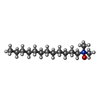+Search query
-Structure paper
| Title | T3S injectisome needle complex structures in four distinct states reveal the basis of membrane coupling and assembly. |
|---|---|
| Journal, issue, pages | Nat Microbiol, Vol. 4, Issue 11, Page 2010-2019, Year 2019 |
| Publish date | Aug 19, 2019 |
 Authors Authors | Jinhong Hu / Liam J Worrall / Marija Vuckovic / Chuan Hong / Wanyin Deng / Claire E Atkinson / B Brett Finlay / Zhiheng Yu / Natalie C J Strynadka /   |
| PubMed Abstract | The bacterial injectisome is a syringe-shaped macromolecular nanomachine utilized by many pathogenic Gram-negative bacteria, including the causative agents of plague, typhoid fever, whooping cough, ...The bacterial injectisome is a syringe-shaped macromolecular nanomachine utilized by many pathogenic Gram-negative bacteria, including the causative agents of plague, typhoid fever, whooping cough, sexually transmitted infections and major nosocomial infections. Bacterial proteins destined for self-assembly and host-cell targeting are translocated by the injectisome in a process known as type III secretion (T3S). The core structure is the ~4 MDa needle complex (NC), built on a foundation of three highly oligomerized ring-forming proteins that create a hollow scaffold spanning the bacterial inner membrane (IM) (24-mer ring-forming proteins PrgH and PrgK in the Salmonella enterica serovar Typhimurium Salmonella pathogenicity island 1 (SPI-1) type III secretion system (T3SS)) and outer membrane (OM) (15-mer InvG, a member of the broadly conserved secretin pore family). An internalized helical needle projects from the NC and bacterium, ultimately forming a continuous passage to the host, for delivery of virulence effectors. Here, we have captured snapshots of the entire prototypical SPI-1 NC in four distinct needle assembly states, including near-atomic resolution, and local reconstructions in the absence and presence of the needle. These structures reveal the precise localization and molecular interactions of the internalized SpaPQR 'export apparatus' complex, which is intimately encapsulated and stabilized within the IM rings in the manner of a nanodisc, and to which the PrgJ rod directly binds and functions as an initiator and anchor of needle polymerization. We also describe the molecular details of the extensive and continuous coupling interface between the OM secretin and IM rings, which is remarkably facilitated by a localized 16-mer stoichiometry in the periplasmic-most coupling domain of the otherwise 15-mer InvG oligomer. |
 External links External links |  Nat Microbiol / Nat Microbiol /  PubMed:31427728 PubMed:31427728 |
| Methods | EM (single particle) |
| Resolution | 3.42 - 6.0 Å |
| Structure data | EMDB-20310: Salmonella SPI-1 injectisome NC-base class 1  EMDB-20311: EMDB-20312: Salmonella SPI-1 injectisome needle complex with assembled needle  EMDB-20313:  EMDB-20314: EMDB-20315, PDB-6pee: EMDB-20316, PDB-6pem: EMDB-20317, PDB-6pep: EMDB-20556, PDB-6q16: |
| Chemicals |  ChemComp-LDA: |
| Source |
|
 Keywords Keywords |  PROTEIN TRANSPORT / Bacterial secretion / PROTEIN TRANSPORT / Bacterial secretion /  type III secretion / outer membrane / type III secretion / outer membrane /  secretin / secretin /  type III secretion system type III secretion system |
 Movie
Movie Controller
Controller Structure viewers
Structure viewers About Yorodumi Papers
About Yorodumi Papers
















